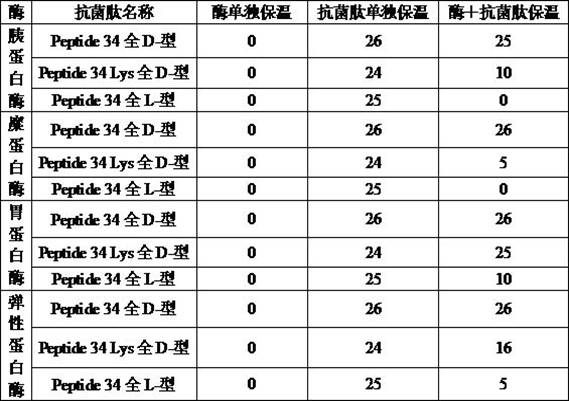Artificially synthesized antibacterial peptide and application thereof
An antibacterial peptide, artificial technology, applied in the field of biomedicine, can solve problems such as affecting antibacterial activity
- Summary
- Abstract
- Description
- Claims
- Application Information
AI Technical Summary
Problems solved by technology
Method used
Image
Examples
Embodiment 1
[0013] Example 1 Preparation of artificially designed synthetic antimicrobial peptides:
[0014] 1. Synthesize all D-type antimicrobial peptides, all L-type antimicrobial peptides and basic amino acid lysine residues as D-type amino acid residues and the rest Amino acid residues are the complete sequence of synthetic molecules composed of L-type amino acid residues. Desalted and purified by HPLC reverse phase C18 column chromatography.
[0015] 2. The molecular weight is determined by Fast atom bombardment mass spectrometry (FAB-MS), using glycerol: m-nitrobenzyl alcohol: dimethyl sulfoxide (1:1:1, V:V:V, volume ratio) as substrate, Cs + As the bombardment particles, the current is 1 electrical microampere, and the emission voltage is 25 Kv.
[0016] 3. The purity of the purified antimicrobial peptide was identified by high performance liquid chromatography (HPLC), and the molecular weight was determined by fast atom bombardment mass spectrometry.
[0017] The sequence of ...
Embodiment 2
[0019] Example 2 Antimicrobial peptides of different configurations inhibit bacterial growth:
[0020] The antibacterial activity detection was carried out according to the conventional doubling dilution method. Add 90 microliters of bacterial solution to each space of the 96-well plate (final concentration 2×104CFU / ml), set 3 duplicate wells in each well, and use pH 7.0 LB medium (10g tryptone per liter, produced by Oxoid Company; 5g yeast Extract, produced by Oxoid Company; 10g sodium chloride, domestic analytical reagent) was used as negative control. Add 10 microliters of antimicrobial peptides prepared with sterile ultrapure water at different concentrations, so that the final concentration decreases exponentially. Incubate at 37°C for 14-16 hours, measure the absorbance of each well at 600 nm, and the lowest concentration with no change in absorbance is the minimum inhibitory concentration (MIC). In order to test the effect of antimicrobial peptides on marine bacteria ...
Embodiment 3
[0031] Example 3 Artificially designed synthetic antimicrobial peptides against protease hydrolysis:
[0032] Experimental method: trypsin, chymotrypsin, pepsin and elastase purchased from Sigma were mixed according to the ratio of enzyme: antimicrobial peptide = 1:10 (molar ratio), incubated at 37 °C for 24 h, and the antibacterial activity of Escherichia coli was tested Determination, the final concentration of antimicrobial peptides were 400 ug / ml. The antibacterial activity was tested by the agarose punching method, and the medium formula was: 1% low-melting point agarose (Sigma A6013), 0.3 mg / ml trypsin jelly (Oxoid product) dissolved in 10 mM pH 7.4Na 2 HPO 4 -NaH 2 PO 4 in the buffer. Add 20 ml of the prepared culture medium at 42°C to culture Escherichia coli ATCC 25922 in the logarithmic phase overnight (approximately 10 5 -10 6CFU), shake well to spread evenly in the 76mm diameter petri dish. After solidification, 3 mm round holes were punched on the culture m...
PUM
 Login to View More
Login to View More Abstract
Description
Claims
Application Information
 Login to View More
Login to View More - R&D
- Intellectual Property
- Life Sciences
- Materials
- Tech Scout
- Unparalleled Data Quality
- Higher Quality Content
- 60% Fewer Hallucinations
Browse by: Latest US Patents, China's latest patents, Technical Efficacy Thesaurus, Application Domain, Technology Topic, Popular Technical Reports.
© 2025 PatSnap. All rights reserved.Legal|Privacy policy|Modern Slavery Act Transparency Statement|Sitemap|About US| Contact US: help@patsnap.com



